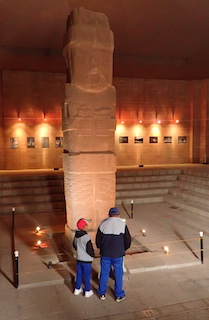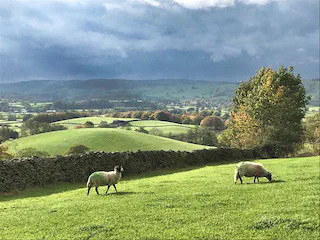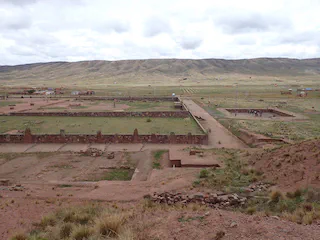
Tiwanaku
- Matthieu P.J.
- Travel
- January 28, 2023
Note: this introductory article will give you context.
Table of Contents
Kalasasaya
According to Graham Hancock, the site of Tiwanaku that lies at 3,870 meters (12,696 ft) above sea level is of great historical importance. In fact, the cover page of his 1995 book “Fingerprints of the Gods” is a picture showing the monolith Ponce, a statue unearthed in 1957 and named after the archeologist that discovered it on the site of Tiwanaku (also spelt: Tiahuanaco).

Monolith Ponce in Tiwanaku
That 3 meters high statue is made of andesite and shows a being standing upright. It has several figures carved on its body: a headband, mask, earrings on the head, a girdle and bracelets on the wrists and ankles, and a skirt decorated with circles. It holds a snuff tablet in its right hand, and a qiru in the left one. There is definitely a mysterious feeling to standing in front of that statue and watching it. Does it represent Viracocha, the creator god?

Monolith Ponce: details of the face (image edited to reveal contours)
And who knows when this statue was carved? It could have been produced up to 17,000 years ago according to Graham… There is definitely an energy to it, and the drawings have a very unique style.
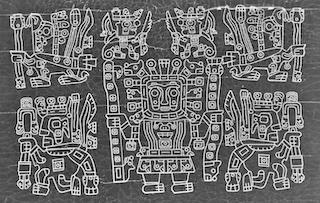
Iconography of Monolith Ponce
The statue is located in the part of Tiwanaku called Kalasasaya (kala for ‘stone’; saya for ‘standing’), an archaeological structure measuring 120 by 130 meters and aligned to the cardinal points. Kalasasaya is part of the main complex of Tiwanaku where 7 temples can be found; a bit further to the south-west lies the pyramid of Puma Punku.
The entire complex had to be partially rebuilt in the 20th century to give it a decent look, because it was badly damaged over the years. Indeed, the monuments were ransacked and used as quarries to build churches and homes nearby. That’s not something unheard of on many similar sites unfortunately… Much of the past was lost because of the ignorance of men. In the end, we don’t even know what happened to the Tiwanaku civilisation. They seemed to have abandoned the area, maybe because of severe draught.
Another impressive stone block in the Kalasasaya complex is the Gate of the Sun.

Gate of the Sun
Stone arrangement and water
It’s worth nothing that many stones were moved from their original location—as in many archeological sites of spiritual importance actually. That changed the original configuration and energy of the site. Why? Well, maybe modern day people could not stand the energy because it was too strong? Maybe there was a desire to ‘deactivate’ the monument in some way? You decide.
Another point is the presence of water at many points in the complex. There are even shafts and draining tunnels in place in several temples. The Akapana pyramid (the largest structure of the main complex) was once filled with water on the top. Like the pyramid of Giza in Egypt where water was present underneath, there is definitely a similar technology that was known to these people: the use of water and stone in particular geometrical arrangements, the stone being modified/programmed in a certain way. Talking of stone, see below.
Magnetic anomalies
On top of the Akapana pyramid, there is a particular stone that local guides know very well about. And for good reasons. That stone has magnetic properties and a compass has its needle spinning near it (an experience that guides will happily share with a compass at hand). There’s something going on here! The stone looks unremarkable from the outside, but sure enough it’s the crystalline structure that matters. Someone has intentionally altered that structure to give it this properties. But why? And how?
Stone generating magnetic anomalies on top of the Akapana pyramid
Kantatallita
East of the Akapana pyramid is a small structure called Kantatallita. There, an Andean cross or chakana can be observed. It encodes the number 28 on each cross (the number of segments used to draw one cross). Considering they are represented by pairs aligned vertically, the number 56 is also encoded. But again, why?
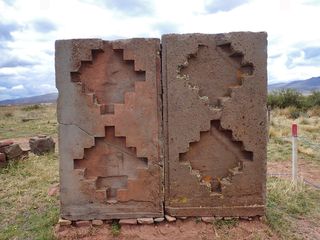
Andean cross in Kantatallita
Subterranean temple
Just east of Kalasasaya is the subterranean temple, discovered only in 1932. It features a court with 175 heads protruding from the walls and is one of the most peculiar places of the sites.

Heads on the walls of the subterranean temple
A statue that stands there today is another large monolith representing a being with its hands clearly visible and placed on his body with a particular configuration: left hand on the navel and right hand on the heart. Is there a message there?
Puma Punku (the ‘Gate of the Puma’)
Now we get to another pyramid, Puma Punku, that lies south-west of all the other ruins. It’s the largest part of all the ruins, on a par with Akapana pyramid I’d say. Now here’s the interesting thing: we know that the water level of lake Titicaca was higher once upon a time. It is believed that the pyramid of Puma Punku was just on the shore of the lake, and could have functioned as a sort of harbour. But today, the lake is more than 10 km away! The site is quite damaged with what seems like random stones lying on the ground. But why was it built away from all the rest? Was it even built at the same period?
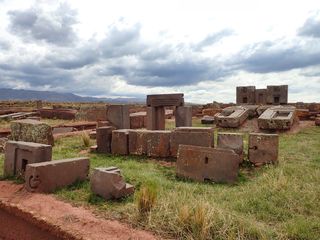
Ruins at the Puma Punku pyramid
Museums
Two museums nearby provide additional context with artefacts collected from the sites. As often, some pieces were taken to far remote locations after their discovery, some of them to be returned at a later date. So is the case of a huge statue called the Bennett monolith that stood in La Paz (the nearby capital) on a square for about 70 years before being finally returned to Tiwanaku! It is by far the largest statue of the site visible today: the piece measures seven meters high and weighs 20 tons. It was discovered by American archeologist Wendel Clark Bennett in 1932.
The Bennett monolith standing in the Museo Litico of Tiwanaku
We also learn some notable facts about the way those people lived. Here’s a selection of things I found relevant:
- Leaders were deforming their skulls to give it an elongated shape. It was done by applying various devices on the head, probably from a young age.
- Agriculture was possible on the bank of lake Titicaca whereas elsewhere it was too dry. Therefore lake Titicaca was regarded as the source of life, very much similar to the Nile in Egypt (a parallel Graham had already drawn based on the reeds boats).
- The llama was a revered animal, and for good reasons! Its existence supported the life of men in the Andes in so many ways: meat for food obviously, but also wool for clothing, fat for lighting, leather for accessories and bones for musical instrument. A very special animal indeed! Oh and even the faeces were used as fertiliser…
- An alcool was made from corn called chicha; another one from quinoa called ch’ua. Both corn and quinoa were the staple foods of the day (and still are today).

